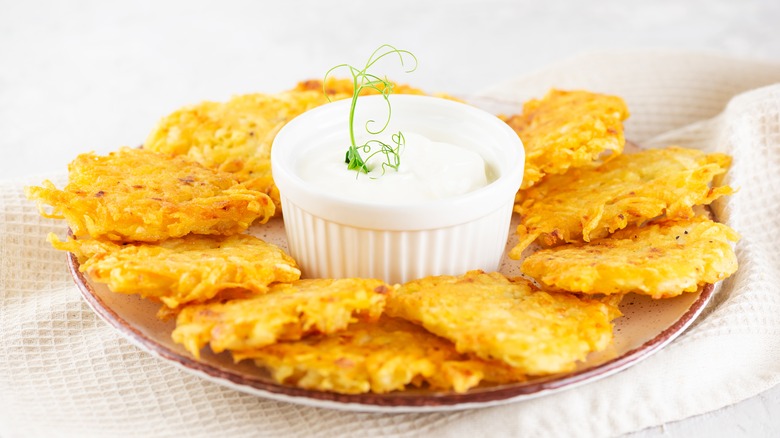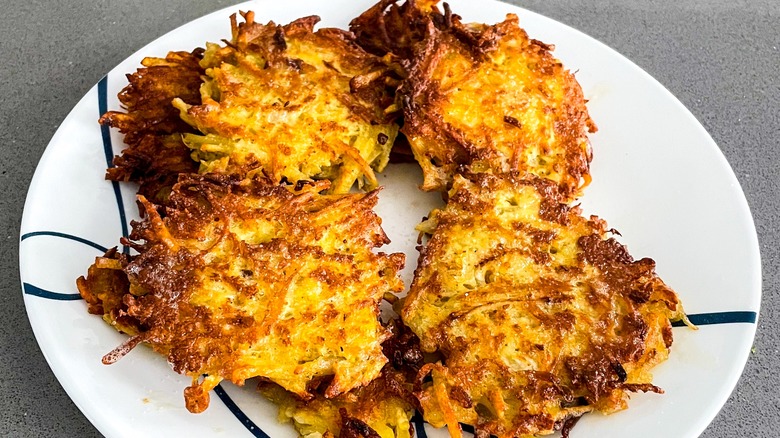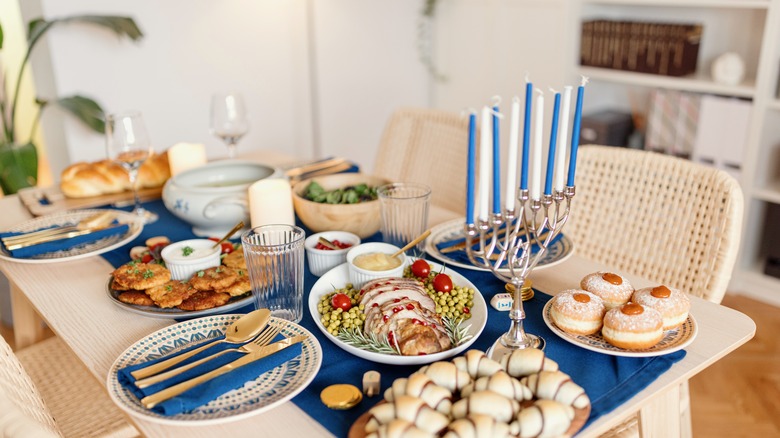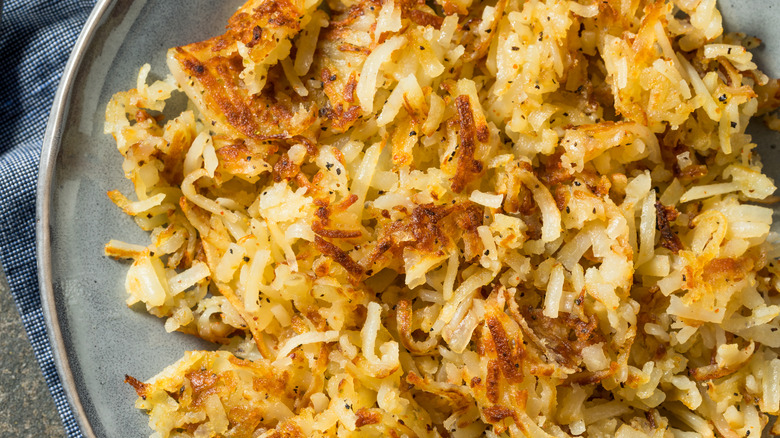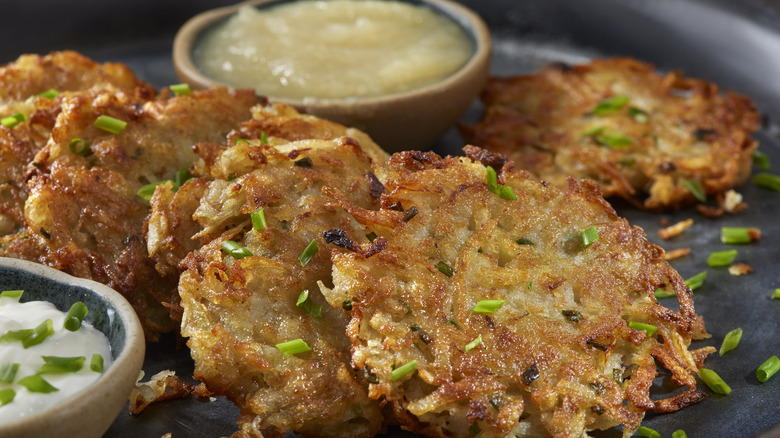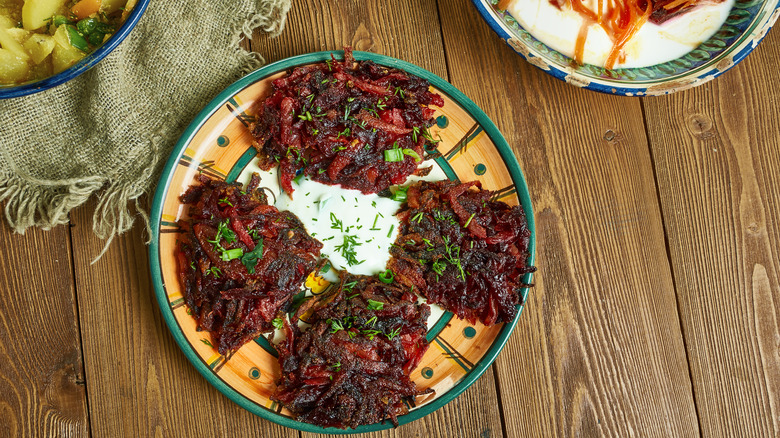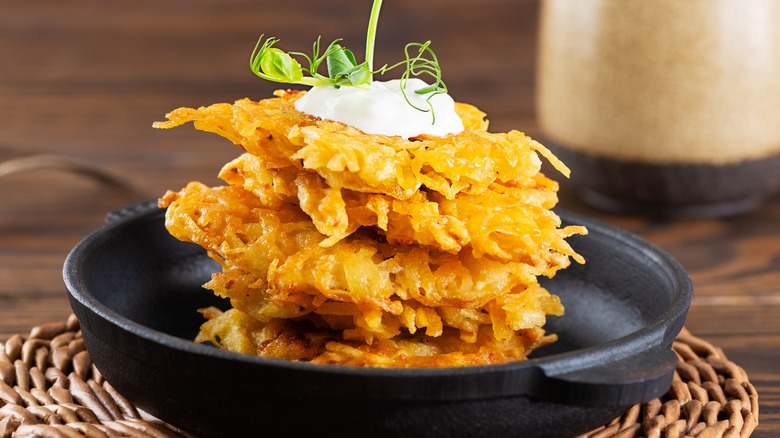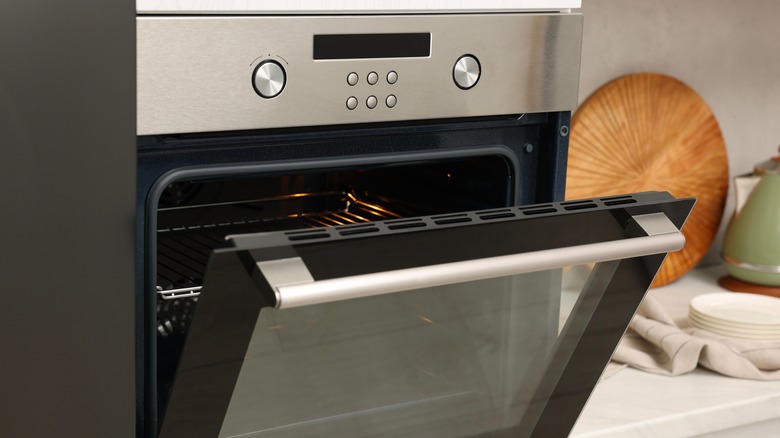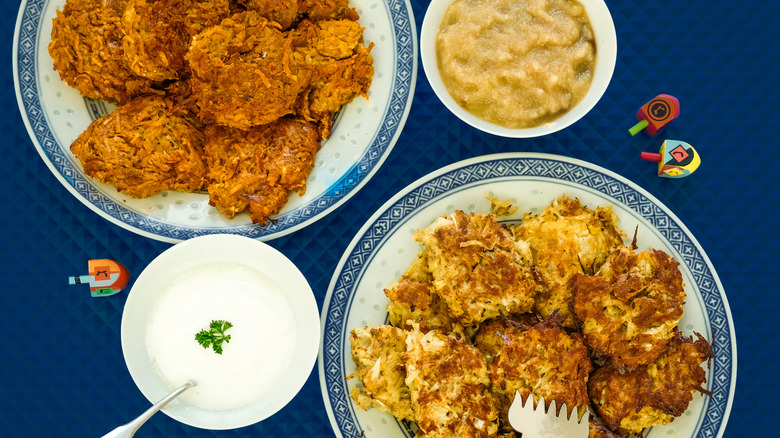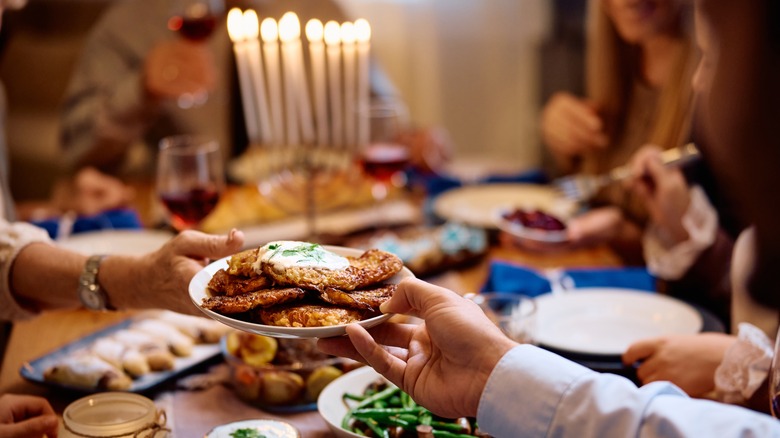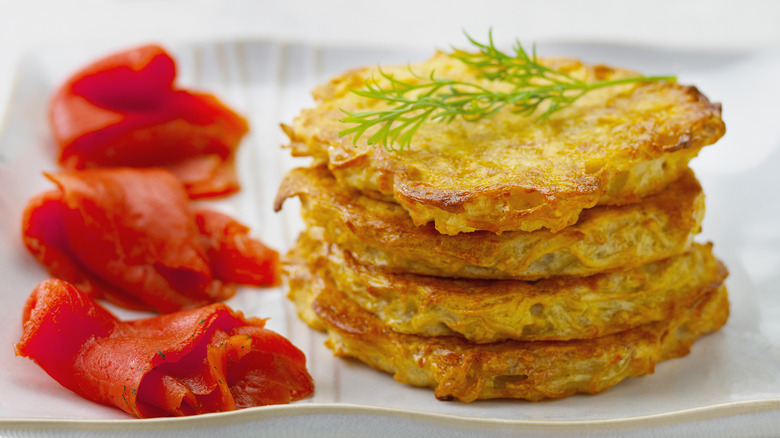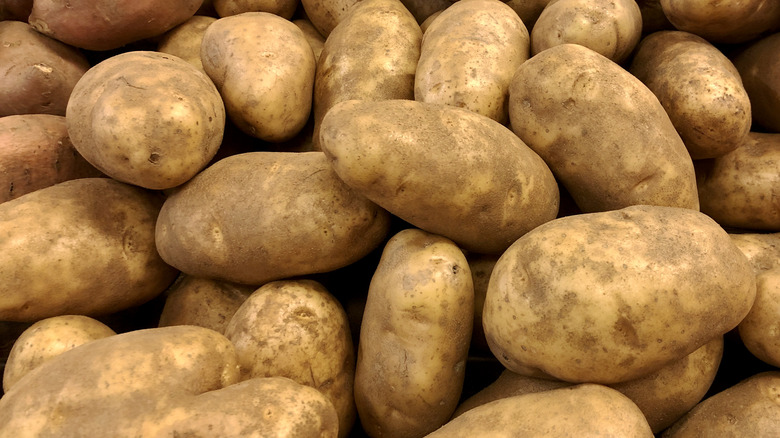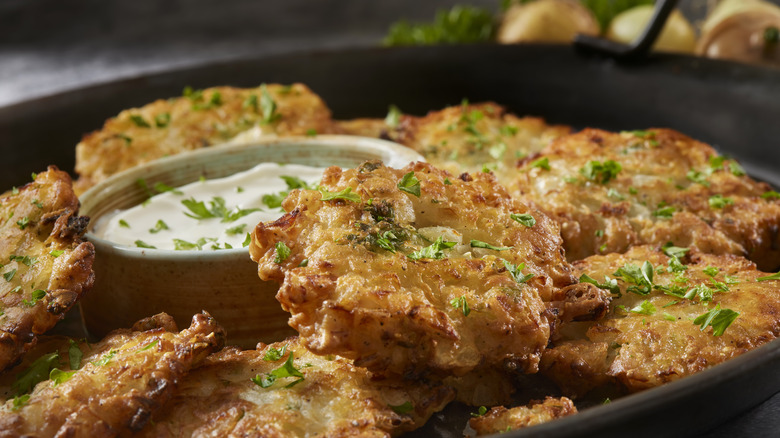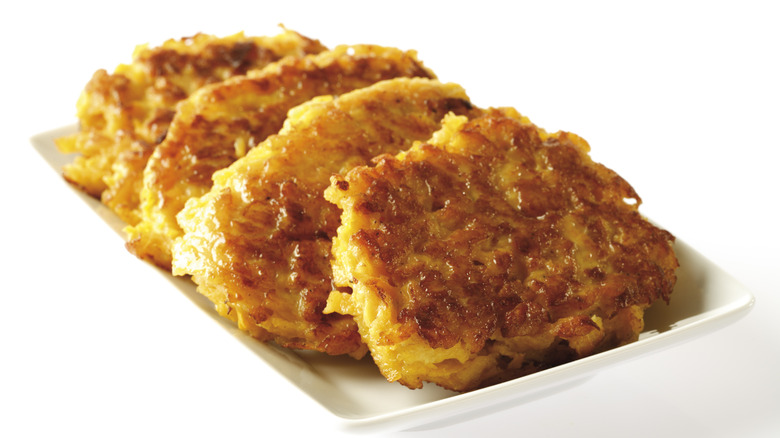What Are Latkes And How Do You Make Them?
As my father is Jewish, I grew up making latkes every year at the winter holidays. They were a classic part of our Hannukah celebrations, served with sour cream and applesauce as well as other holiday classics, such as roast chicken.
When I got older and married into a big Jewish family, I learned there are alternative ways to make these light, delicious fritters and expanded my repertoire. In college, when I was feeling lonely or nostalgic for home, I'd whip up a batch for friends – and I still do sometimes. The rest of the year, I make them any time I want to impress someone (though I call them potato pancakes if we're outside of that Festival of Light window, even though that is a bit of a misnomer).
Put simply, latkes are delicious. They're a perfect excuse to eat lots of sour cream (always a good thing) and they make a great side dish at non-Hannukah times of year, or for non-Jewish peeps in general. Given what a classic dish they are, everyone should know how to make them.
What are latkes?
Most people love potatoes and don't need to be sold on their merits. Ditto for onions, which become deliciously sweet and juicy when cooked up quick and hot. As for fried foods, well, enough said – they're fried, and it's what we all live for (Or, at least this writer does.) If you can agree to the preceding statements, then you need latkes in your life. They're the perfect combination of crispy and juicy, with lacy outsides and moist, fragrant insides – but what exactly are they?
Latkes are a cross between potato pancakes and fritters. Essentially, they are a combination of shredded potatoes and onions, with some eggs and flour to hold them together and form a thick, lumpy batter, fried in oil to create a crisp, golden effect. Round them out with a little seasoning, and you have a soul-satisfying mix of salt, fat, and crunch that simply can't be beat.
As already stated, latkes are a traditional Hannukah food that originated in Eastern and Central Europe, but they are now associated with the holiday in countries around the world. Plus, while latkes are a seasonal holiday favorite – and that's certainly the context in which most people know them best – their ingredients are pretty simple and can be enjoyed all year round.
Historical significance of latkes
The Jewish people are big on food symbolism. You need only look at a traditional seder plate to see this: bitter herbs representing the horror of slavery; charoset to mimic the mortar used to build Pharoah's monuments; shank bone to harken to the sacrifice made before Exodus. The contested historical accuracy of the Passover tale is less important here than the point that Jewish folk love using food as metaphor, and that holds true for Hannukah, too.
In other parts of the world, certain foods are associated with the story of Judith, who beheaded the Assyrian General Holofernes and saved the Jews. Because she fed him salty cheese, some Jews make cheese pancakes to celebrate her.
As for Hannukah, its story focuses on the Maccabean Revolt, so named for the Maccabees, a Jewish family that led a successful rebellion against their Greek overlords. After recapturing Jerusalem, they reconsecrated the Temple, but only had enough oil for one night. Instead, it burned for eight. For this reason, Jews are taught to celebrate this miracle by cooking foods in oil.
Potatoes were not available in Eurasia until the 1600s, so it's no surprise that the latke only dates back a few hundred years, though there was a potato-free precursor dating further back. Along with potatoes, onions and oil were cheap ingredients that helped commemorate the mythology of Hannukah. The word "latke" stems from the Slavic word for fried pancake, which stems from the Greek word for olive oil.
Latkes versus potato pancakes and hashbrowns
Before proceeding, it's a good idea to clear up a common misconception. Latkes might seem like they're the same as hashbrowns at surface level, but they aren't. Hashbrowns are just shredded potatoes, sometimes with onion or onion powder, and they are cooked all in one layer in a pan. Some recipes use oil, others butter, but there is little tradition behind them other than that of gorging oneself on fried potatoes in the morning, which is always a good idea.
Similarly, they might seem the same as potato pancakes, but true to their name, the latter are much more pancake-like, often using mashed potatoes in the recipe. Alternatively, recipes may call for cooks to pulse potatoes into a fine powder that looks like Kraft parmesan cheese. It results in a very smooth batter with less crunch and more softness. While delicious, these are not latkes, either.
The basic ingredients of latkes
Almost all latkes contain a few basic ingredients: potatoes, onions, eggs, salt, and flour or matzo meal, plus oil for cooking. Typically the potatoes are russets, as they grate up firm and white and are easy to peel. They're also known for getting crispy on the outside and soft on the inside (hence their ubiquity in French fries) as a result of their high starch content. However, you can also use other types of potatoes, such as wax or sweet, though in my experience these are harder to work with.
Some recipes call for cooking the latkes in schmaltz, which is rendered poultry fat, such as chicken or goose. The majority of recipes simply call for veggie oil of some kind, while some specify you choose those with a high smoke point, such as avocado, peanut, or grapeseed oil. You can add a small amount of schmaltz to the cooking oil if you want the flavor boost.
Lastly, latkes require eggs and dry ingredients to bind the mixture, and salt to season it. Some recipes also call for pepper, which is a matter of personal taste. Dry ingredients range from flour to matzo meal to bread crumbs to potato starch, or some combination, all dependent on the specific formula. If you haven't made them before, the best idea is to start with a classic potato latke recipe.
Nontraditional latke ingredients
Although the classic Hannukah latke is made with potatoes and onions, many traditional recipes include zucchini and cheese. As such, it's actually a misnomer to call these ingredients nontraditional, and you can freely experiment with them while still staying true to their roots.
There are other ingredients, however, that are less culturally rooted. For example, if you want to move beyond a classic latke recipe, you might try subbing out potatoes for sweet potatoes. Sage and apple sweet potato latkes are a win if you're looking for a spin that doesn't take a lot of specialty ingredients and will work well for a fall spread. Make them with grated apples for a dessert approach.
You could also try wax potatoes, which present less liquid to deal with, or even a potato-free mix altogether, such as cauliflower or beets. At that point, you're basically moving into fritter territory, and recipes for all of these are available online. You can also put ingredients into your latkes to make them seasonally appropriate, such as pumpkins in the fall. Cheddar cheese is another popular addition that makes a protein-rich, vegetarian weeknight meal.
Basic latke preparation
Latkes are made by grating potato and onion, mixing in egg and flour or matzo meal along with seasonings, and frying in hot oil. To make good latkes, make sure your potatoes are well-drained and your oil is hot. You also need to use the right cookware, fry them for long enough, and drain them appropriately when done.
Some recipes call for you to soak the potatoes while you grate the onions; others do not. Either way, you need to drain them well by pressing them into a colander or (as this writer does) plopping them into a dish towel and squeezing them through it. Nice and dry is the goal. Then mix with eggs, dry ingredients, and seasonings.
While doing this, heat your oil. You want about ¼ inch, enough to completely cover the bottom and come halfway up the side of the latke. When it looks hot, drop a bit of batter in and wait for it to sizzle. Time to fry latkes by placing heaping spoonfuls in the pan, then lightly mashing them down. Watch out for spatter and make sure when you fry latkes that you do not overcrowd them. Remove when brown on both sides and drain on a grocery bag or paper towel.
Note to the air fryer owners out there: You can also make latkes in your favorite countertop convection oven, and they come out perfectly crispy without soaking up all that oil. A waffle maker also does the trick.
How to keep latkes warm before serving
Since they are classically a holiday food (or otherwise a party food), latkes are often served in huge amounts. The problem is that they must be fried in small amounts, a juxtaposition that is every cook's nightmare. (See: eggs Benedict and crêpes.) Ideally, you want to serve them as soon as possible after frying, but that's not always possible. Take heart, though: There is an answer.
The trick is to keep latkes crispy in the oven. If you're not going to serve them right away, make sure you remove them from the paper towels or grocery bags immediately after placing them there to soak up grease, or they'll get soggy. Instead, put them on a rack so the air can circulate under them and avoid the sogginess problem. A 200-degree Fahrenheit oven works well for this, keeping them warm and crunchy without drying them out.
What to serve latkes with for Hannukah
If you are serving latkes for a traditional Hannukah dinner, then there are a few must-have condiments. First, sour cream. Make sure you get the full-fat kind, as there's really no point buying watery or carrageenan-laden substitutes for this dish. You want thick, rich sour cream that will stay in a dollop even on a hot latke.
Second, applesauce. This is more of a dealer's choice. Some like it smooth, others chunky; some sweet, others not. Homemade is better. All you have to do is peel, core, and chop apples, then put them on the stove with a little water, sugar, cinnamon, and lemon juice (all of which are optional other than the water). Let it cook down over medium heat, then mash together. If you can't swing homemade, jarred is fine. Just test your jarred applesauce ahead of time to make sure it's nice and thick; the watery ones will immediately de-crisp your latkes.
Serve both sour cream and applesauce in bowls that can be passed. Avoid the temptation to prepare and garnish ahead of time, as this will just increase the odds of sogginess and people like to add their own amounts anyway.
Other foods to accompany latkes at Hannukah
Every family celebrates Hannukah differently (and we have even been known to celebrate with ham, the ultimate lax Jew fare). However, there are some traditional Hannukah foods with which latkes pair exceptionally well. If you're making a traditional meal for the Festival of Lights, you'll want to choose a few of these to serve with your latkes.
Roast chicken is a big one. It's super easy to make, so if a good roast chicken isn't already in your culinary repertoire, remedy that pronto. Plus, a chicken can bake quietly on its own while you prepare your latkes. You'll just want to remove it and turn down the oven before you begin frying so that you can keep the latkes warm when they come out of the pan. Though beef was almost never on the table in my house growing up, brisket is another popular latke accompaniment.
Kugel, challah, and matzo ball soup are all popular choices as well. For veggies, you can go with a simple salad or steamed vegetable. Lastly, for dessert, rugelach are delicious, though my preference is for sufganiyot, traditional jam donuts akin to beignets. Though these are labor-intensive as heck, they are worth it in the end ... but prepare for spatter during the frying.
Latke serving variations
Latkes are associated with the story of Hannukah, of course, but you don't have to eat them exclusively during the winter holidays. There are so many latke variations that it's possible to enjoy them all year round with different toppings. First up, you can make them as heavier potato pancakes (big on the flour or matzo meal) or lighter fritters that focus on potatoes and onions almost exclusively (which is how I like them).
For instance, latkes are really not that far from a potato pancake or Russian cocktail blini you might serve with lox and sour cream, and you can vary them to fit with other culinary traditions. Think feta and spinach for a Greek spin, curry for Indian, or beets for Russian flavor. Make eggs Benedict with latkes as a base rather than English muffins? You bet. You can also whip some goat cheese and sprinkle chives over them for a classed-up spring or summer dish. Truly, the sky is the limit.
Sourcing latke ingredients
Latkes depend on only a few ingredients, so you want to make sure they're good. Happily, said ingredients are neither expensive nor difficult to procure. Just make sure you have good, firm russet potatoes and nice sweet onions. Wax potatoes cook differently, so if you're going to experiment with those, it's a good idea to have your basic latke recipe down pat first.
Where possible, you want nice, fresh eggs for latkes. You can tell an egg is older because the white will be clear instead of cloudy. The white also gets watery over time, indicating the egg is stale, though still safe to cook with unless it's pink or pearly in color. Ideally, if you crack the egg on the counter, it will not spread very far. That means it's nice and thick, perfect for holding your batter together.
As for flour, any kind is fine, though whole wheat and other nontraditional flours will likely make your latkes heavier. Don't bother with fancy for your matzo meal if using: Manischewitz is just fine. Regarding oil, use whatever type your recipe calls for, but sniff it first to rule out rancid oils, which will transfer their flavor to your latkes.
Where to find latkes already made
There is not, unfortunately, an abundance of places to find ready-made latkes. However, you can usually source them at a Jewish deli. Look for them while you're on the hunt for Reuben sandwiches, for instance, or while conducting a tour of America's must-visit delis. Zaftig's, for instance, has loaded latkes for sale; you know they're good because the word "zaftig" in Yiddish roughly translates to "plump."
Follow along with Guy Fieri on "Diners, Drive-Ins and Dives" for some other delicious Jewish food haunts, such as Perly's in Richmond, Virginia. They have potato latkes for sale, and if you're not up to the task of making them yourself and live in the area, it might be worth a visit. Katz's is always a good choice if you're in New York City. You can also just google "latkes + [your area]" and come up with a restaurant or two.
Feel like making them yourself, but don't want to go all the way? You can find latkes in the frozen section of some stores as well as in boxed mix form. Trader Joe's, believe it or not, has two latke versions: a basic potato one as well as a cheesy cauliflower option for the gluten-free set, both of which you can warm in the oven. If you're more interested in a boxed mix, Manischewitz has you covered here as well. All you need to do is add eggs and water, then fry up in oil. Instant yum.
Storing leftover latkes
If you're smart, you'll make more latkes than you need. They are a pain in the you-know-what to grate, drain, mix, and fry, so it's never a bad idea to make a huge batch and keep some for later. They reheat quite well and you will enjoy the leftovers almost as much as the original.
Make sure before storing latkes to cool them to room temperature. This will prevent them from giving off steam that turns into soggy condensation. Leftover latkes can be stored in the fridge. I usually store them in a single layer in a flat container or, if you want to stack them, with wax paper or paper towel between them. That way, you can easily separate them for reheating. You can also freeze them using the same techniques.
Reheating is best done in the oven or air fryer, where you can circulate dry air to recreate that crisp. Don't re-fry latkes, which will only make them hard and unappealing, not to mention total gut bombs.
Nutritional information
Let's get real: latkes are not a health food. While onions are good for you, and eggs certainly have their place in the food pyramid, potatoes and oil are hard to sell as über-healthy. This is not to say you shouldn't eat latkes, of course, since they are manna from heaven and few holiday foods are low-calorie anyway. Consumed in moderation, latkes are fine, but you should be aware of the nutritional information going in.
The exact nutritional content of your latkes will depend on the ingredients, the recipe, and the temperature of your frying oil. Hotter oil cooks latkes faster while soaking up less of it, so make sure your bath o' fat is as hot as it should be before plunking batter in. That said, the average latke can range from 100 to 215 calories per serving. If you're worried about it, you can check the nutritional info on most recipes.
